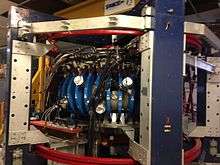Hybrid Illinois Device for Research and Applications
| Type | Stellarator, Tokamak |
|---|---|
| Operation date | 1972 - 1982 (as WEGA, Grenoble), 1982 - 2000 (as WEGA, Stuttgart), 2001 - 2013 (as WEGA, Greifswald)2014 - Present (as HIDRA, Urbana, IL) |
| Size (Major radius/Minor Radius | 0.72 m / 0.19 m |
| Plasma volume | 0.51 m3 |
| Magnetic field | < 0.5 T |
| Heating | 26 kW 2.45 GHz magnetron |
| Location | University of Illinois at Urbana-Champaign |

The Hybrid Illinois Device for Research and Applications (HIDRA) is a medium-sized toroidal magnetic fusion device currently being assembled within the Center for Plasma Material Interactions in the Department of Nuclear, Plasma and Radiological Engineering at the University of Illinois at Urbana-Champaign, United States. It is anticipated that HIDRA will have first plasma by mid-September 2015 and start full experimental campaigns by December of that year. HIDRA is the former WEGA classical stellarator that was operated at the Max-Planck Institut für Plasmaphsyik in Greifswald Germany from 2001 - 2013.
A unique aspect of HIDRA is that it can not only operate as a stellarator but also as a tokamak, hence the hybrid designation. In fact it should be possible to operate the two modes simultaneously. It is planned to operate up to 30 minutes of continuous plasma, with up to 60 minutes in the future and will concentrate on understanding the complex relationship between the plasma and materials inside the vacuum vessel of a fusion device
History
HIDRA is probably the most well traveled fusion devices in the world. From its beginnings in France it has operated in 3 countries and 4 cities. The research goals of the device have dramatically changed over the years from doing wave heating studies, to being a testbed for one of the worlds most sophisticated fusion devices and now to studying the way plasmas interact with the inside wall and materials of fusion devices. In fact it will be the first toroidal fusion-relevant device that will be dedicated to the study of plasma wall (PWI) and plasma material interactions (PMI).
Centre d’Etudes Nucléaires in Grenoble, France (1972 - 1982)
HIDRA, in fact, started off as a different machine at the Centre d’Etudes Nucléaires in Grenoble, France in 1972. Back then it was called WEGA with construction of the device from 1972 to 1975. WEGA was a joint project between CEA Grenoble and the Max-Planck-Institut für Plasmaphysik in Germany to study RF heating and lower hybrid heating. There were three vacuum vessel that were built, two tokamak and stellarator. WEGA primarily operated as a tokamak from 1975 to 1982 despite plans to install the stellarator vessel in 1976 (repeairs were needed on the helical coil insulation). Electron and ion temperatures achieved were, Te = 600 - 900 eV and, Ti = 150 - 250 eV. Densities of ne = 1.6×1019 m−3 with a plasma current of IP = 45 - 60 kA and heating power, Pohm = 100 - 130 kW and, PRF = 100 kW. Typical pulse duration was, Δt = 5 - 15 ms and an energy confinement time, τE = 3 - 5 ms.
Institut für Plasmaforschung (IPF), University of Stuttgart, Stuttgart, Germany (1982 - 2000)
In 1982 WEGA moved from Grenoble to the University of Stuttgart in Germany. Unfortunately inn Stuttgart it seems that WEGA was not used much. There is not a lot of information from this time and its is very difficult to see what results came out of this 18 year time period. The issues seem to be a lack of enough heating power and cooling. However, IPF did have the stellarator vacuum vessel installed and some of the first magnetic flux surface measurements were performed.
Max-Planck-Institut für Plasmaphysik, Greifswald, Germany (2001 - 2013)
From 2000 - 2001 WEGA moved from Stuttgart to Greifswald. At this stage a new institute had been built in the former East German city to stimulate economic, scientific and educational growth in the region. MPIPP Greifswald was designated to house the brand new modular stellarator W7-X.